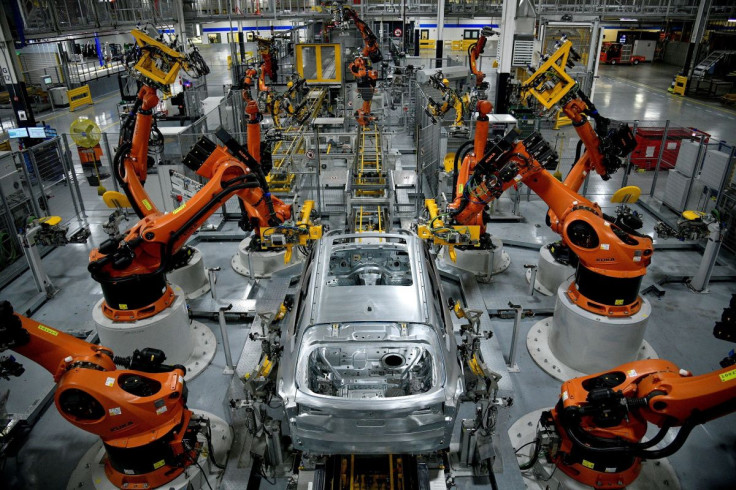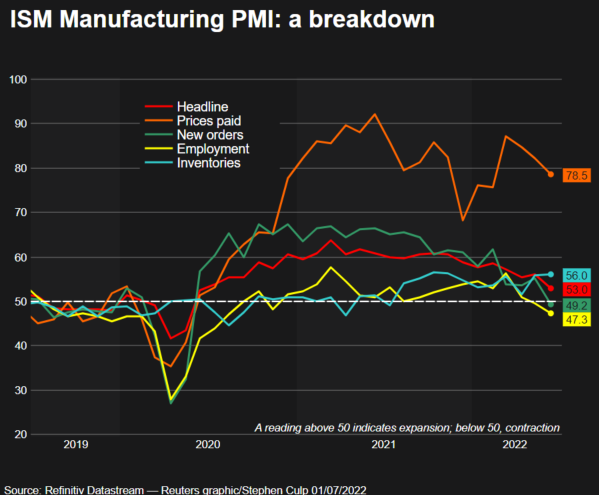U.S. Factory Activity Slows To Two-year Low In June

U.S. manufacturing activity slowed more than expected in June, with a measure of new orders contracting for the first time in two years, signs that the economy was cooling amid aggressive monetary policy tightening by the Federal Reserve.
The survey from the Institute for Supply Management (ISM) on Friday also showed a gauge of factory employment contracting for a second straight month, though an "overwhelming majority" of companies indicated they were hiring.
The slowdown in manufacturing followed on the heels of moderate consumer spending growth in May as well as weak housing starts, building permits and factory production, which left some economists anticipating that the economy contracted again in the second quarter after gross domestic product slumped in the first three months of the year.
"Investment spending is starting to weaken, which only adds to the evidence that the U.S. economy is rapidly slowing," said Shannon Seery, an economist at Wells Fargo in New York.
The ISM survey's index of national factory activity dropped to 53.0 last month, the lowest reading since June 2020, when the sector was rebounding from a COVID-19 slump. That followed a reading of 56.1 in May. A reading above 50 indicates expansion in manufacturing, which accounts for 11.8% of the U.S. economy.
Economists polled by Reuters had forecast the index would fall to 54.9. Some of the moderation in factory activity reflects a shift in spending back to services from goods.
All of the six largest manufacturing industries - computer and electronic products, machinery, transportation equipment, petroleum and coal products, food and chemical products -- registered moderate-to-strong growth.
ISM manufacturing PMI

The Fed last month raised its policy rate by three-quarters of a percentage point, its biggest hike since 1994, to quell high inflation. Another similar-sized rate hike is expected in July. The U.S. central bank has increased its benchmark overnight interest rate by 150 basis points since March.
The ISM survey's forward-looking new orders sub-index dropped to 49.2 from a reading of 55.1 in May. That was the first decline in the index below the 50 level since May 2020.
U.S. stocks were trading lower. The dollar rose against a basket of currencies. U.S. Treasury prices were higher.
SOFTENING ORDERS
Slow orders growth was a recurrent theme among most businesses, with only a few, including transportation equipment manufacturers and electrical equipment, appliances and components makers, saying demand remained strong, the ISM survey showed.
Food producers reported that "business is slower than expected in volume," though they were "already receiving large orders for the fall." Machinery producers said "our suppliers are experiencing a softening of orders."
Still, manufacturers have plenty of work on hand to keep factories humming. Backlog orders continued to accumulate at a steady pace in June.
Though business inventories were revised sharply higher in the first quarter and major retailers like Walmart and Target have reported they are carrying too much merchandise, the ISM survey still viewed stocks at clients as "too low."
Makers of apparel, leather and allied products acknowledged the excess inventory held by their customers and said they "expect orders to decline in the coming months until inventories are leveled properly against demand."
Some economists perceived the strong inventory build last quarter as a sign that supply chain bottlenecks were easing.
Indeed, the ISM survey's measure of supplier deliveries tumbled to 57.3 from 65.7 in May. A reading above 50% indicates slower deliveries to factories.
"This easing in the supplier deliveries index could be related to a reduction in supply chain issues but also a weakening in demand," said Daniel Silver, an economist at JPMorgan in New York.
News on inflation was encouraging. A measure of prices paid by manufacturers dropped to a reading of 78.5 from 82.2 in May, supporting the view that inflation has probably peaked.
A combination of waning demand and worker shortages likely resulted in the survey's measure of factory employment declining further to a reading of 47.3 from 49.6 in May. Technology companies like Tesla have been laying off workers.
With 11.4 million unfilled jobs across the economy at the end of April, economists caution against reading the continued weakness in factory employment as a sign that overall payrolls growth was faltering.
"Purchasing managers say they are cutting staff, but job layoffs haven't hit the weekly unemployment benefits data yet," said Christopher Rupkey, chief economist at FWDBONDS in New York. "The employment index was below 50 last month as well and yet May nonfarm payroll jobs for manufacturing went up 18,000."
© Copyright Thomson Reuters 2024. All rights reserved.





















